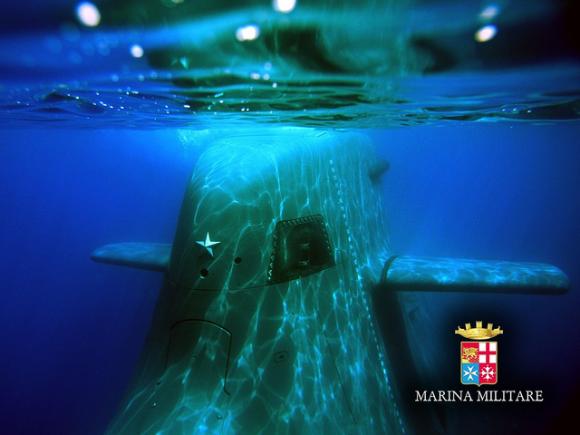A holiday in Salento brings to the collective imagination to think of beautiful beaches, "pasticciotti" with cream accompanied by "coffee in ice" with almond milk, and discos.
What does this have to do with a visit to the COMFLOTSOM?
It has to do, because while in the nightclubs of Gallipoli the boys still today, (incredible but true, since we are a few decades after publication), are unleashed on the notes of "In the Navy", propaganda song for enlistment in the Navy of the United States, a few kilometers away and in absolute silence, there are those who during the CONUS exercise have managed to get in position to be able to torch one of the most important aircraft carriers of that same US Navy!
È so a real pleasure to take away a day at the beach and invest it to get to know this elite department better.
What we are about to describe is the mere chronicle of a visit - almost improvised - written with the hope that it will at least partially transmit the feelings we have experienced.
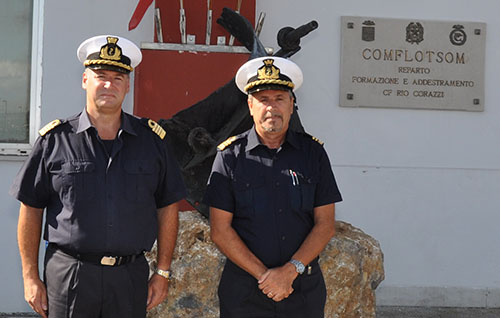 The experience begins with a warm and cordial welcome from the ship captain Mario Berardocco, commander of COMFLOTSOM, and the frigate captain Antonio Tasca, head of the public information cell, who accompany us all morning and do their utmost in explanations.
The experience begins with a warm and cordial welcome from the ship captain Mario Berardocco, commander of COMFLOTSOM, and the frigate captain Antonio Tasca, head of the public information cell, who accompany us all morning and do their utmost in explanations.
Right from the start we are introduced in the museum hall, small but collecting pieces of inestimable historical, military and even industrial value (such as the drawings of "Dolphin", The first Italian submarine dating back to the 1892).
In this corner of history, there is not only that to be proud of the technological intuition: above all there is the vivid memory of many acts of heroism and sacrifices that the submariners have never forgotten and that distinguish their history.
The very fact that our visit starts from here, shows how important this centuries-old history is and how much these values of self-sacrifice and spirit of sacrifice are still current and at the base of the ethics of these Men of the sea.
Yup, Men of the sea, because even before being officers and commanders of highly technological men and military means, there is in their heart a subtle thread that binds them to anyone who spends his life in the blue giant, even the most humble of fishermen. And this makes them even more deserving of admiration.
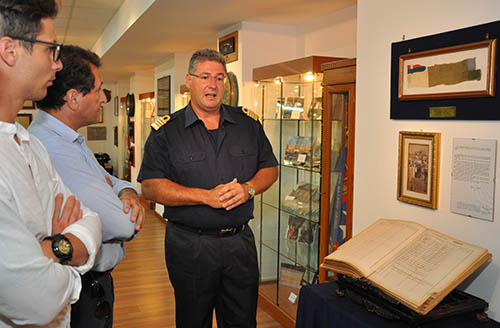 This initial moment of our visit lends itself well to some anecdote, and so we delve into the details of the American aircraft carrier within the torpedo during the CONUS exercise.
This initial moment of our visit lends itself well to some anecdote, and so we delve into the details of the American aircraft carrier within the torpedo during the CONUS exercise.
Well, that exercise has shown that our submarines class Todaro (batch I and II, whose technical characteristics are reported at the end of the article) when they arrive in the operations area have nothing to envy, for effectiveness, nuclear submarines in force to countries with economic resources that allow continuous investments (not cuts, as happens to us) to the Defense.
The Germans are well aware of this. They share the same type of "boat" (as the commanders who have dedicated their precious time) to us, spare parts and even training with our Navy. In fact, in the 2012, their crew was trained here in Taranto.
… And the Americans know it too, after having seen the photograph of their aircraft carrier, taken from the periscope of our submarine in fire position (Online Defense EXCLUSIVE, last photo below). Photograph that in addition to demonstrating that it has managed to evade the protection of an entire Naval Squad of what is believed to be the most powerful naval force in the world, it even managed to snatch a brotherly smile of satisfaction from a senior US Navy officer as a submariner (smile immediately "retracted" returning to the rigor appropriate to his status as a member of the General Staff).
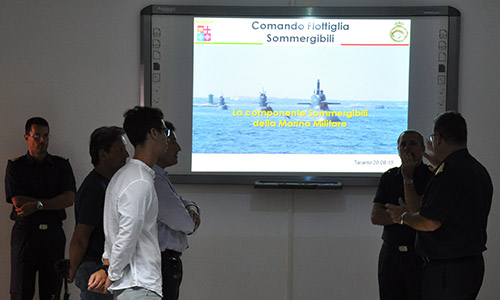 Our hosts explain to us the organization, the tasks and the endowment of the submarine component, also describing the technical characteristics of the vehicles and especially the current roles and missions of our submarines.
Our hosts explain to us the organization, the tasks and the endowment of the submarine component, also describing the technical characteristics of the vehicles and especially the current roles and missions of our submarines.
And here we really realize how this means can be effective for the most different daily jobs, going well beyond its first, obvious role of first line of attack.
Or rather, to put it in words Loro, the evolution of the use of the submarine is the transition from a simple vector to a weapon, to "Advanced Sensor".
Our newspapers do not talk about it, but there is an intense underwater work (underwater in a broad sense, since many are investigations covered by confidentiality constraints) essential to prepare, develop and support the most appropriate intervention to the case.
Thanks to the optical and radar, electromagnetic, infrared and acoustic concealment capabilities, combined with the ability to transmit data in real time (images, videos, electro / acoustic signatures captured by periscope, I / R video camera, AIS, hydrophone, ESM SATCOM), our submarines are today the most suitable means to consolidate their original tasks (Sea Control, Sea Denial and Naval Force Support) to which today new and very important ones are added that go far beyond the imagination, even for purposes unrelated to tactical use.

Among these:
- Presence and hidden surveillance (ISR). On-site strategic role of investigation and protection, also in collaboration with other institutional bodies and police forces.
- Indications and Warning (I&W), a role particularly useful today for tracing, up to the arrest and effective individual identification of smugglers and pirates.
- Monitoring of illicit traffics and transhipments, fight against terrorism and environmental crimes.

Then there are the special operations (SPECOPS) that can go from the submarine rescue to the support of other Police Corps and Armed Forces, even with the transport of special equipment.
Last, but only by order of treatment, the most important scientific contributions (oceanographic, metrological, with reference to applications and inherent to underwater acoustics and underwater environmental surveys, useful for the study of cetaceans and the evolution of their vital habits.
To be able to live up to all these tasks, Tactical and Logistic support and adequate training of all the personnel involved in these activities are essential.
We have already mentioned the collaboration with Germany regarding spare parts for the Todaro class submarines, of which even Germany is equipped. The relationships in this sense are so good that they can almost consider the existence of a real sharing of the logistic resources, in the respective structures, which are particularly structured by virtue of the special materials stored in them.
 Our visit continues instead with the Training and Training Department (Scuola Som) and also for this type of structure we have already mentioned the collaboration already given to Germany.
Our visit continues instead with the Training and Training Department (Scuola Som) and also for this type of structure we have already mentioned the collaboration already given to Germany.
Here the crews in training perform a theoretical-practical path that starts with the Submarine Basic Training and continues with specific training differentiated by role.
The submariner will attend numerous courses in order to be able to effectively and safely carry out all subsequent on-board assignments. ... And in order to become commander of a submarine, it is necessary to have covered every board task foreseen for the officers.
The vastness of the training is such that the second master of a submarine is equipped with medical skills that can perform an appendectomy, with the only help of the nurse on board ... And we are not talking about a medical officer!
The training facilities allow you to be prepared for every situation, ordinary and emergency.
A "Rush escape" simulator and an individual exit allows you to stay fit with emergency evacuation procedures.
A floodable room also equipped with smoke generators (called "Falla and smoke" simulator) and individual respirators allows you to train yourself to be able to analyze and solve serious but not irrecoverable problems.
Then we visit the Computer-Based-Training rooms, the multimedia room and those instrumented identically to the real submarine to allow officers and non-commissioned officers to become familiar with the various systems and their operating procedures, without having to go sailing with the real boat.
We will find these same devices in their exact same arrangement, first on the simulators, then on the submarines "Gazzana" and "Todaro" that await us at the piers.
 But before visiting these two boats, after having also illustrated the "Sauro class" simulator", the commander-in-chief of COMFLOTSOM pays tribute to us to attend a short simulation of submarine diving a "Class Todaro ", performed under his command.
But before visiting these two boats, after having also illustrated the "Sauro class" simulator", the commander-in-chief of COMFLOTSOM pays tribute to us to attend a short simulation of submarine diving a "Class Todaro ", performed under his command.
Remarkable the feeling of realism: we almost descend from the simulator with seasickness (and it was just force 4!)
What most impresses and galvanizes is to observe the perfect functioning of the "chain of command", ie the precise execution of orders (subject to verification) by all the professional figures involved in running one of the most modern submarines in Europe, as of competence, to each single order of the commander.
I make a parallel with the aeronautical world, which I know well and find something familiar (not only the production by the AVIO of Turin of the "Sauro class" simulator), but everything is much more complex. I find it simply fantastic to see all these men who know perfectly what to do, each for their own competence, in the context of a single team work, with absolute precision.
It affects above all the security and naturalness of the commander in ordering descents, turns and changes in speed of a medium that moves with bat eyes in a living environment and the backdrop is not infinite and irregular. It seems that the commander "wears" a submarine war like a second skin, and we have been catapulted into one of the scenes of "Hunt for Red October", well aware of not being on a film set!

When we get off the simulator, we'll have a visit to the room where the "de-briefing "that follows the simulated mission.
And here too we find something very similar to that seen in the aeronautical environment, and more precisely at the 61 ° Stormo dell'Aeronautica Militare for the M-346. A structure almost the same for structure and technological setting, consisting of a room perfectly equipped to review the mission just simulated, evaluate functional parameters and instrumental indications, to highlight any areas of improvement.
And finally we are moving towards the pier.
 Here we visit two exponents of our submersible fleet: one per class.
Here we visit two exponents of our submersible fleet: one per class.
For the Sauro class, the “Gazzana” awaits us. The ritual of greetings between the COMFLOTSOM commander who guides us and the commander of the submarine who welcomes us on board with extreme cordiality is always exciting.
There are more than 40 years of the project, especially in terms of ergonomics, but for many of the tasks we have described, it is still an adequate means.
We immediately notice certain solutions of other times (such as the camp beds placed exactly above the torpedoes) and we also allow ourselves to make an arrangement with the U-boat exhibited at the Deutsche Museums of Monaco.
We also see the propulsion engine system: 3 diesel engines and 1 electric motor, obviously not present on the simulator, just as it is not the room where all human activities take place, when they are not navigating when they are not moving.
Considering that we have already seen the dashboard in both the technical classrooms and the simulator, its appearance already has almost a familiar aspect, demonstrating the effectiveness of the training system developed.
And this also allows us not to ask other technical details, indeed, to give us a chat in the aforementioned room, in relation to the filmography about the world of submarines, from K-19 a Hunt for Red October, passing through the unforgettable U-boot 96.
But we also find time to talk about COMFLOTSOM's acquired ability to carry out some small repairs on its own, without having to resort to external construction sites. On the other hand, it is necessary to make a virtue of necessity and so, as the average age of the crews has grown, also in terms of management economics here in Taranto they have been able to do an excellent job.

Left the Gazzana and climbed on Todaro, the perception of almost half a century of technological progress is immediate.
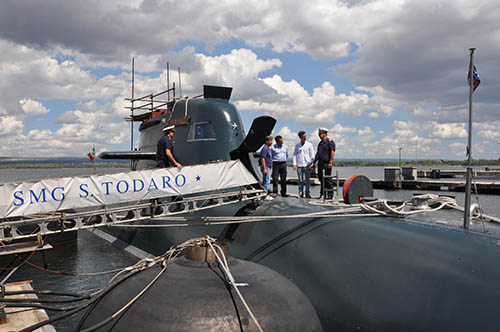
From "civilians", the first thing we notice is the "human" space available. But as technicians, every detail illustrated confirms the technological progress. Just to name a few, the propulsion system (a single Diesel engine and a gigantic electric car), the AIP (Air Independent Propulsion) fuel cell propulsion system, the high-strength non-magnetic steel construction, the initial launch of the torpedoes that occurs with impulse to water to reduce its acoustic traceability.
Regret after this visit? Yes, two.
The first is to be greeted by people to be truly proud of having had the privilege of knowing.
The second is not to see the same enthusiasm of those young people who dance to the notes of "In the Navy", in approaching professions such as that of the submariner, more than anything else for their leaving the road to a life full of satisfaction and "true" values.
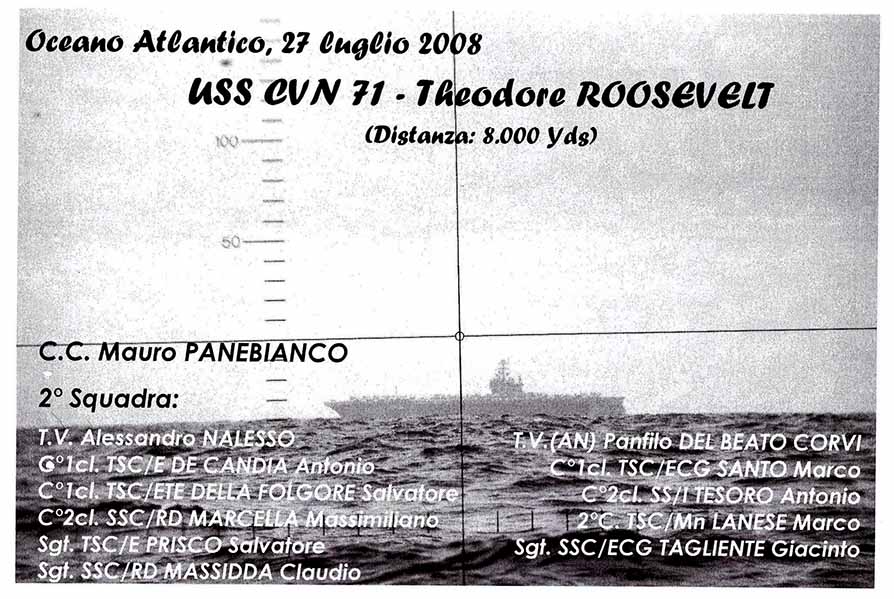
"SAURO" class submarines
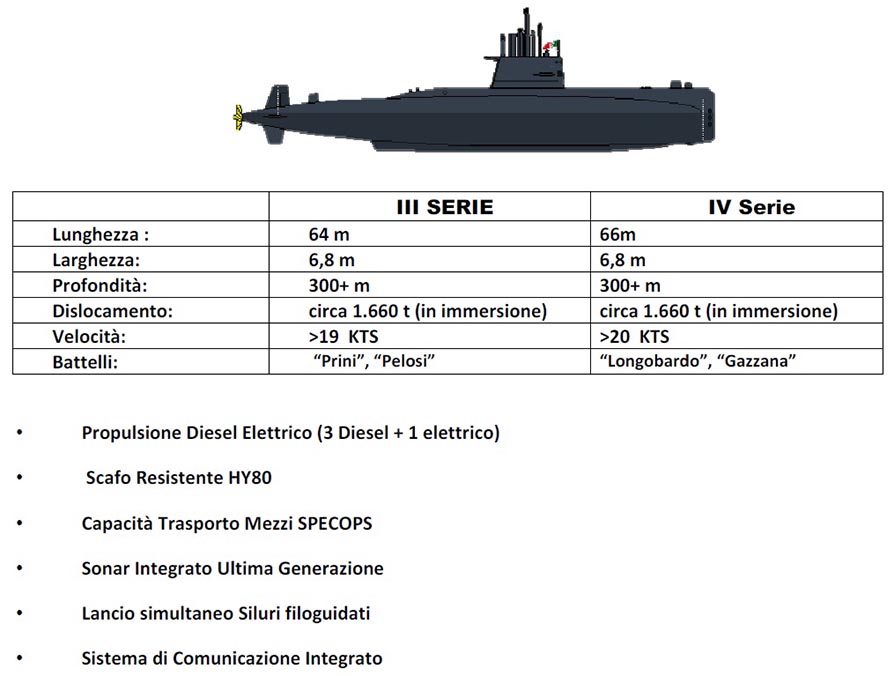
Submarines class "TODARO" (U2012A)


